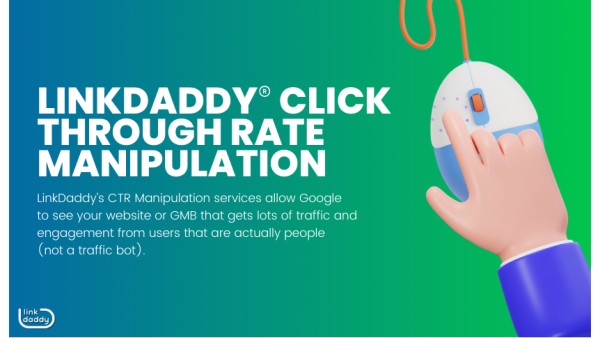Why a Committed CTR Manipulation Service is Important for Your Advertising Method
Why a Committed CTR Manipulation Service is Important for Your Advertising Method
Blog Article
Transform Your Ad Campaigns With Targeted CTR Adjustment
Reliable ad projects hinge on the intricacies of click-through rate (CTR), an important metric that reflects audience engagement. Targeted CTR manipulation, notified by information analytics, offers a method to refine just how ads connect with potential clients.
Recognizing Click-Through Price
What makes a click-through rate (CTR) an important statistics in digital marketing? CTR is the percentage of individuals that click a certain link out of the total variety of customers that check out a website or an ad. It offers as a crucial indicator of the efficiency of online marketing campaigns, reflecting how well the web content reverberates with the target market. A high CTR recommends that the ad is appealing and relevant, while a low CTR suggests a need for optimization.
Understanding CTR enables marketers to examine the efficiency of various projects, ad styles, and targeting strategies. It enables for benchmarking versus market standards, providing insights into areas that may need enhancement. Additionally, CTR plays an essential function in search engine optimization (SEO) and pay-per-click (PAY PER CLICK) advertising, affecting high quality scores and general visibility in search results page.
Relevance of Targeted CTR

In addition, targeted CTR control enables marketing experts to fine-tune their strategies based upon target market habits and choices. By examining data, organizations can identify which sectors respond favorably to details content types and adjust their campaigns as necessary. This precision brings about a lot more impactful messaging and greater conversion prices.
Additionally, targeted CTR promotes brand commitment. In summary, the relevance of targeted CTR lies in its capacity to not only boost campaign effectiveness yet also to create significant connections with target markets, leading the way for sustained development and success.
Techniques for CTR Control
How can marketers effectively control click-through rates (CTR) to attain preferred results? A number of strategies can be used to enhance CTR, therefore maximizing the efficiency of ad campaign.

Second, making use of distinctive visuals can dramatically influence CTR. Premium photos or videos that straighten with the advertisement's message can draw attention and prompt individuals to click. Leveraging advertisement placement purposefully on systems where the target audience is most active can improve presence and interaction rates.
Third, customizing ads based upon customer behavior and choices can yield much better results. Utilizing retargeting methods, marketers can remind possible customers of service or products they formerly viewed, thus boosting the likelihood of clicks.
Lastly, enhancing for mobile is critical, as a considerable section of web traffic comes from mobile devices. Ensuring ads are mobile-friendly can lead to improved CTR and overall campaign performance.
Studying Audience Behavior
Comprehending target market behavior is vital for marketers intending to boost click-through prices (CTR) and total project effectiveness. By diving right into the motivations, preferences, and on the internet routines of target market, marketing experts can customize their projects to reverberate even more deeply with potential customers.
Analyzing audience habits involves several crucial elements, consisting of market analysis, psychographic profiling, and user journey mapping. Market evaluation provides insights right into age, area, revenue, and sex, which can educate the style and messaging of ads. Psychographic profiling, on the other hand, uncovers lifestyles, worths, and rate of interests, allowing marketers to develop content that aligns with target market desires.
Customer trip mapping is essential for understanding how potential clients engage with different touchpoints, from first recognition to last conversion. By recognizing the stages where target markets disengage or engage, marketing experts can enhance their strategies to boost CTR.

Determining Campaign Success
Measuring campaign success is a critical element of any type of advertising approach, as it gives the required insights to examine efficiency and drive future decisions. To efficiently evaluate success, marketers have to develop clear, quantifiable purposes lined up with overarching business goals. Trick performance indicators (KPIs), such as click-through rates (CTR), conversion rates, and roi (ROI), serve as vital metrics in this process.
Tracking CTR particularly allows marketing professionals to analyze the effectiveness of targeted advertising campaign. A high CTR suggests that the advertisement reverberates with the target market, while a low CTR may demand a reevaluation of targeting criteria, creative elements, or messaging methods. Furthermore, examining conversion rates provides deeper insights into exactly how well a campaign drives wanted activities, such as sign-ups or acquisitions.
Leveraging analytics devices can further boost dimension efforts, enabling real-time data monitoring and changes. Consistently evaluating project efficiency versus established criteria guarantees continuous renovation and optimization. Eventually, a durable measurement technique not only highlights successes however additionally reveals locations for enhancement, leading the way for much more efficient and impactful advertising and marketing campaigns in the future.
Final Thought
In verdict, transforming ad projects via targeted click-through price (CTR) adjustment requires a comprehensive understanding of target market habits and reliable messaging strategies. Ultimately, these methods add to enhanced brand name loyalty and taken CTR Manipulation full advantage of return on financial investment, emphasizing the relevance of targeted CTR manipulation in electronic advertising.
Effective advertisement projects pivot on the complexities of click-through price (CTR), a vital metric that reflects audience interaction. A high CTR suggests that the advertisement is appealing and appropriate, while a reduced CTR suggests a need for optimization.
In recap, the importance of targeted CTR lies in its ability to not only enhance campaign effectiveness but also to produce purposeful connections with audiences, paving the method for continual growth and success.
A high CTR suggests that the advertisement resonates with the audience, while a reduced CTR might necessitate a reevaluation of targeting parameters, imaginative elements, or messaging approaches.In verdict, changing ad campaigns via targeted click-through rate (CTR) adjustment demands an extensive understanding of audience actions and reliable messaging methods.
Report this page